What do eagles eat?
Eagles, Fish, and the Food Chain
An eagle’s average daily food consumption is from 250-550 grams per day, or between 5-10% of an eagle’s body weight.
Sunlight Fuels the Food Chain
Bald Eagles, like other animals, get all their energy from the sun. Of course, they could sit out in the sunshine their whole lives and die of starvation! So, how can the sun be the source of their energy?
Let’s start at the beginning. Sunlight is the source of energy for plants. Using the sun’s energy, green plants produce food through photosynthesis. Tiny plants called algae grow in lakes. Without the algae, there would be no food for any of the animals, and without the sun, there’d be no algae. Read on to see how the chain unfolds.
Green Algae
Water Fleas
Nymph
Algae are the main source of food for little animals called daphnia or water fleas.
- It takes about ten grams of algae to grow about one gram of tiny water fleas.
Some aquatic insects eat these tiny water fleas. An example is the dragonfly nymph. Dragonfly eggs hatch into nymphs that live in the water for months or even years. When they leave the water they shed their final nymph skin, and open up their wings to become adults. When these adults breed, they will lay their eggs in the water to start a whole new cycle.
Dragonfly nymphs eat many little creatures in the water, including water fleas:
- It takes about 10 grams of water fleas to produce about one gram of insect.
Small fish eat many aquatic insects, including dragonfly nymphs:
- It takes about 10 grams of insects to produce one gram of small fish.
Some medium-sized fish eat smaller fish. An example is the largemouth bass:
- It takes about 10 grams of smaller fish to produce one gram of these medium-sized fish.
In turn, the medium-sized fish are food for large fish:
- It takes about 10 grams of medium-sized to produce one gram of these large fish.
Finally, the large fish are food for other living things — like eagles!
- It takes about 100 grams of large fish to produce one gram of eagle.
Why does the eagle need so much more food for its weight than fish, insects, or water fleas need? (Hint: Consider whether a species is warm-blooded or cold-blooded, and what this would mean for food requirements.)
What Do Eagles Eat?

What Do Eagles Eat? Eagles are powerful birds with sharp beaks. These birds are very symbolic to humanity to the extent that they are the subjects of an array of principles essential to humans.
A majority of these birds can be found in Africa and Eurasia. 2 species are present in the US and Canada, 3 species in Australia and 9 species exist in Central and South America.
Eagles are mostly carnivorous. Depending on the species, their palette includes small mammals like prairie dogs, squirrels, rabbits, chinchillas, raccoons, waterfowls, and fish.
Table of Contents
What do Eagles Eat?
| Type of Eagle | Diet |
|---|---|
| Bald Eagle | Salmon, catfish, herring, shad, rabbits, crabs, reptiles, amphibians and other birds. |
| Golden Eagle | Marmots, prairie dogs, jackrabbits, squirrels, mice, voles, birds, snakes, large insects, lizards, foxes, young deer, and carrion. |
| African Fish Eagle | Catfish, lungfish, flamingoes, other water birds, carrion. |
| Long-crested Eagle | Rodents, especially vlei rats. |
| Philippine Eagle | Philippines flying lemur, monitor lizards, snakes, and other birds. |
| Steppe Eagle | Steppe pika, voles (Brandt and Eastern Kazakhstan), reptiles, other birds, insects, squirrels, and carrion. |
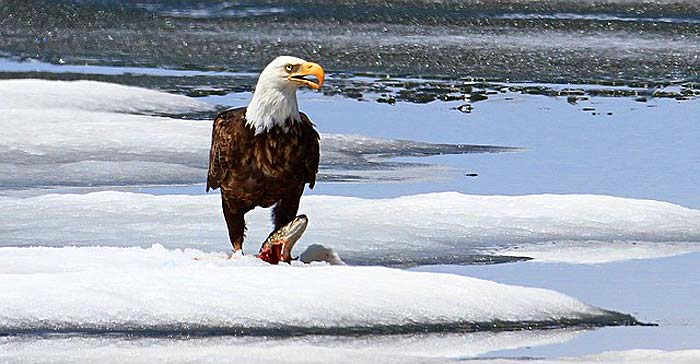
Eagles Diet by Types
About 60 eagle species exist. They can be found in all continents of the world except Antarctica. They are classified in the family Accipitridae, and they belong to many genera. This section will sample out types of eagles from across the world.
What Do Bald Eagles Eat?
| Kingdom | Order | Family | Genus | Species |
|---|---|---|---|---|
| Animalia | Accipitriformes | Accipitridae | Haliaeetus | Haliaeetus leucocephalus |
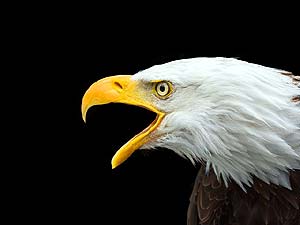
Bald eagle feeds on a variety of products, which include salmon, catfish, herring, shad, rabbits, crabs, reptiles, amphibians, and other birds. This eagle can eat live.
- The bald eagle appears bald thanks to its head having white feathers, which contrasts the brown hue on its body and wings.
- Bald eagles were previously endangered, but because of its protection, its numbers have flourished over the years.
- The bald eagle inhabits areas next to water bodies, especially regions close to coasts and lakes.
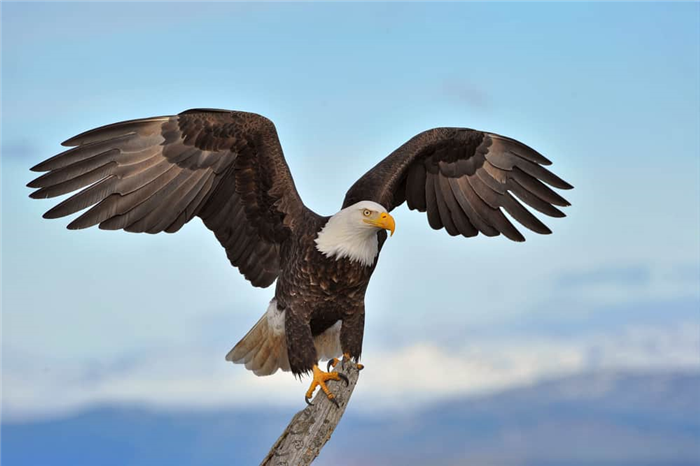
What Do Golden Eagles Eat?
| Kingdom | Order | Family | Genus | Species |
|---|---|---|---|---|
| Animalia | Accipitriformes | Accipitridae | Aquila | Aquila chrysaetos |
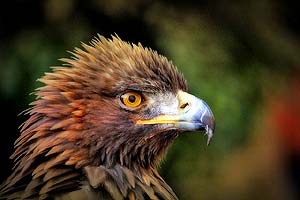
Golden eagle feeds on marmots, prairie dogs, jackrabbits, squirrels, mice, voles, birds, snakes, large insects, and lizards. Golden eagles (aka adler birds) can also prey on larger animals like foxes, young deer, and carrion.
- Golden eagle is considered as an enormous bird of prey in North America.
- This type of eagles is notable for its light golden-brown feathers on their necks and heads.
- Golden eagle inhabits a vast range of areas including but not limited to foothills, plains, mountains, rangeland, prairies, tundra, and the open country.
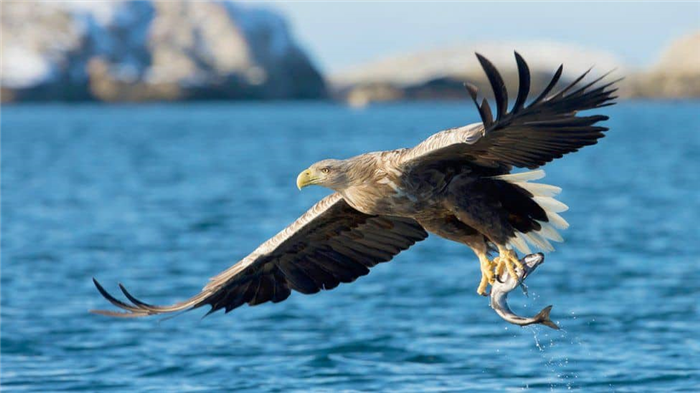
What Do African Fish Eagles Eat?
| Kingdom | Order | Family | Genus | Species |
|---|---|---|---|---|
| Animalia | Accipitriformes | Accipitridae | Haliaeetus | Haliaeetus vocifer |
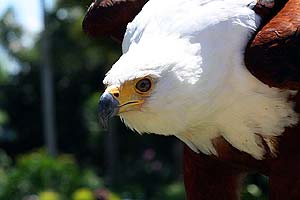
As the name suggests, African fish eagle mostly feeds on fish (catfish and lungfish to be precise). The African fish eagle also eats flamingoes, other water birds, carrion, and other larger prey found on the ground bordering water.
- The African fish eagle is a large eagle species which spots white, black, and brown plumage.
- This type of eagle can be found in trees next to lakes, rivers, and on coastlines.
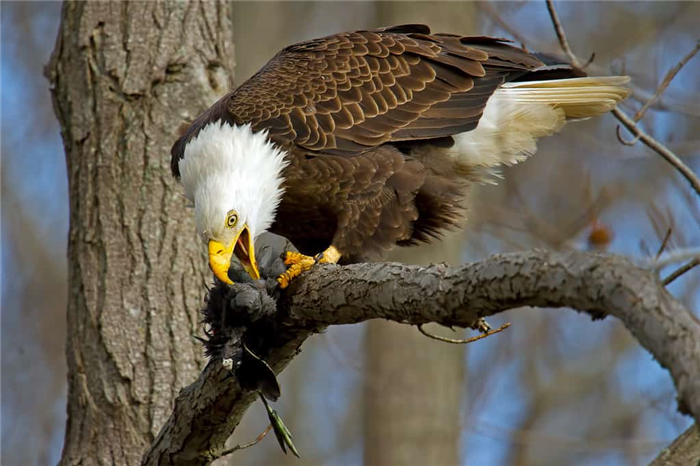
What Do Long-crested Eagles Eat?
| Kingdom | Order | Family | Genus | Species |
|---|---|---|---|---|
| Animalia | Accipitriformes | Accipitridae | Lophaetus | Lophaetus occipitalis |
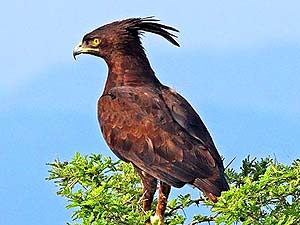
Long-crested eagle feeds on rodents, especially vlei rats.
- The long-crested eagle gets its name from the long crest present on its head.
- This type of eagle is mostly black or dark brown, and it has white patches on the joints of its wings.
- Its habitat types include grassland, savannah, forests, wetlands (inland) and artificial lands.
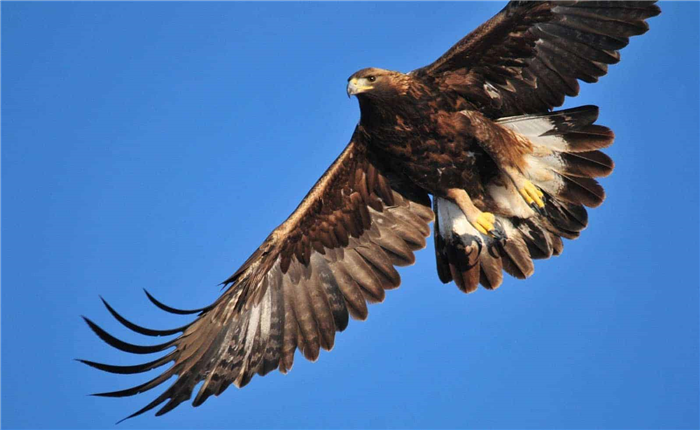
What Do Philippine Eagles Eat?
| Kingdom | Order | Family | Genus | Species |
|---|---|---|---|---|
| Animalia | Accipitriformes | Accipitridae | Pithecophaga | Pithecophaga jefferyi |
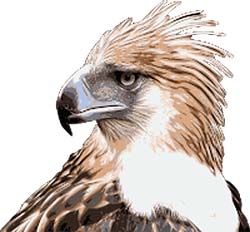
Philippine eagle primarily predates on the Philippines flying lemur. It also eats monitor lizards, snakes, and other birds.
- Philippine eagle is a powerful bird of prey previously referred to as the monkey-eating eagle.
- As the name suggests, this bird is endemic to the Philippines.
- This species inhabits montane forests (steep terrain).
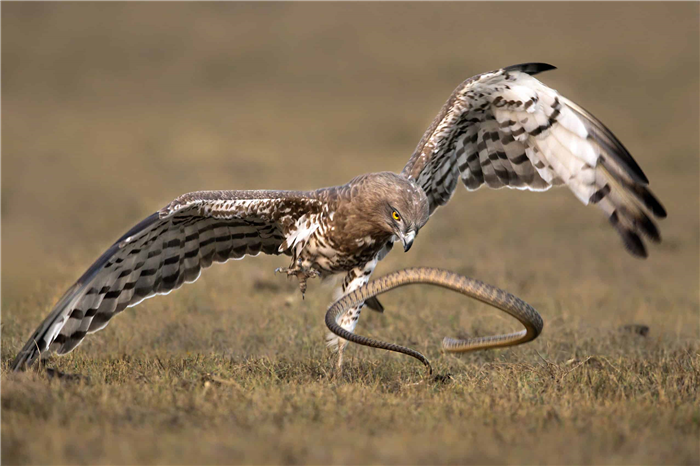
What Do Steppe Eagles Eat?
| Kingdom | Order | Family | Genus | Species |
|---|---|---|---|---|
| Animalia | Accipitriformes | Accipitridae | Aquila | Aquila nipalensis |
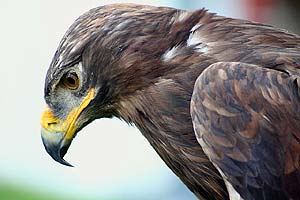
Steppe eagle feeds on steppe pika, voles (Brandt and Eastern Kazakhstan). They also eat reptiles, other birds, insects, squirrels, and carrion.
- The steppe eagle is a large eagle species.
- As its name suggests, it mostly inhabits steppes.
- Steppe eagles can also be found in deserts, grasslands, semi-deserts and agricultural areas.
How Do Eagles Hunt?

For eagles, hunting is an analytical process facilitated by tact.
- Their speed comes in handy to aid their quest to capture prey.
- Eagles can detect their prey by soaring high, by watching them from high perches, or by flying lowly over slopes.
- Once eagles identify their prey, they use their speed to ambush their victim and snatch it using their sharp talons.
The Eagle’s Diet in a Nutshell: Detailed Breakdown
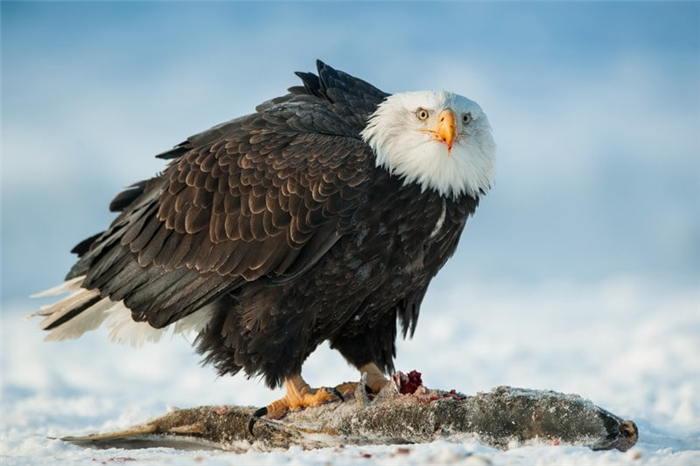
Have you ever watched an eagle take flight? Did you take the time to notice how little effort it took? These birds are among the highest-flying aviators, reaching altitudes of 10,000 feet, sometimes more. This is only one of the reasons as to why the eagle has symbolized courage, strength, and freedom. But how are these animals able to reach such heights? This question cannot be answered without the simple question, “What do eagles eat?”

Table of Contents
WHAT DO EAGLES EAT?
Eagles are strict carnivores, preying only on meat. These birds get their sustenance from small mammals, reptiles, fish and other birds. There are few species that have opportunistic tendencies where they will steal from others or eat from carrion, which is a dead animal.
The food that they eat has a lot to do with their physical characteristics, or morphology. Certain adaptations have gifted these animals with the title “Bird of Prey”.
EAGLE TAXONOMY
It is well known that eagles most commonly include large birds. They technically belong to the family Accipitridae, all of which are grouped for their intensely hooked bills. Size and coloration play a role but will vary between species. No matter how small, eagles tend to share wings that are both powerful and aerodynamic. Another interesting commonality is in the way they watch their prey. Some birds, such as owls, are able to rotate their heads 270 degrees. Most eagles, on the other hand, look over their shoulder behind them just moments before they strike their prey.
With a hooked bill, powerful wings, and a keen sense of sight, these animals are able to thrive in the wild.
WHAT DO EAGLES EAT IN THE WILD?
The eagle is regarded as a cosmopolitan animal, meaning that you can find it in every corner of the world aside from Antarctica. In fact, there are over 60 species, all of which differ in hunting preferences and size. To truly understand what eagles eat in the wild, we must examine the most unique species found.
Golden Eagle
You can’t study eagles without the largest bird found in North America. The Golden eagle (Aquila chrysaetos) ranges in weight from 3 to 6 kilograms with a wingspan reaching 78 inches. For reference, a gull typically has a wingspan of 60 inches. As the name suggests, they are covered with a mixture of brown and golden feathers and sport a bright yellow beak. These birds prefer to dwell in the countryside where vegetation is tall. They will also take refuge in forests with minimal human development.
Those who study birds, ornithologists, have found their distribution is primarily located in North America while some may be found in Asia, Africa, Europe, and Alaska. With such a large size, it’s no surprise that they can eat a wide variety of food.
On the heavier end, they can attack deer and livestock. They tend to stick to small mammals such as squirrels, marmots and one of the favorites, the Black-tailed jackrabbit. In addition, they will consume various reptiles, fish and carrion.
Crowned Eagle
The Crowned eagle (Stephanoaetus coronatus) is quite the spectacle with a colorful layering of dark brown followed by bands of white. The crown is the most distinctive feature. These birds weigh between 2 and 4 kilograms and have a wingspan of up to 70 inches.
It is commonly known as the African crowned eagle due to its distribution. The Crowned eagle is limited to sub-Saharan Africa, where it prefers riparian woodlands and some forested areas.
Given the name “Africa’s strongest predator” is anything far from the truth. These birds take on a myriad of potentially dangerous prey such as poisonous snakes, monkeys, young antelope, rodents, skunks, armadillos, and smaller birds. In fact, this is one of the few species of bird to hunt down a grown monkey.
White-bellied Sea Eagle
Different from the other two species described before, the White-bellied sea eagle (Haliaeetus leucogaster) sports mostly white or grey feathers with darker wings. These individuals tend to weigh around 4.5 kilograms and have a wingspan reaching up to a staggering 86 inches.
With “sea” in the name, there’s no surprise that it can most often be seen around the coasts of Australia, New Guinea, Indonesia, India, and China. They thrive best when living in habitats that have coasts, islands or estuaries.
As one would assume, these birds do in fact get their sustenance from more aquatic animals. These meal options include fish, turtles and sea snakes. They will also prey on small mammals, fellow birds and carrion to round out their diet. Surprisingly, scientists have found that this species of eagle is more likely to hunt down a fish rather than a rabbit.
WHAT DO EAGLES USE TO HUNT?
There are a number of tools that an eagle uses to locate and kill the needed meal, whether that were a monkey, small mammal or fish.
Eagle Eyesight
It has been proved again and again that humans do not have the best eyes in the animal kingdom. Well, one of the top contenders for the best eyesight is the eagle. With eyes roughly the same size as ours, they are about 4 to 8 times stronger than a human with average vision. They also use both monocular and binocular vision, meaning that they can use each eye independently from one another if need be. These improvements have made it possible for an eagle to see a rabbit that is as far as 3.2 kilometers away.
Tactful Talons
If you were to take a close look at an eagle’s foot, you might notice 4 toes, or talons where one is facing toward the back. This special talon is called the “hallux”. With a toe that faces in this direction, the bird can grip the prey more easily. The Bald eagle (Haliaeetus leucocephalus) is the largest sea eagle in North America, weighing in around 3 to 6 kilograms. The talons of a Bald eagle have been proven to grip at a rate of about 400 psi, pounds per square inch. That is 10 times stronger than a human gripping your hand.
Warring Wings
With such large wings, these birds are specifically designed to catch their prey from the air. Consider the fact that these wings not only have to support the weight of the eagle, but also the size of the captured prey. They also have the ability to conserve energy through feathers that are long and wide. This aids in gliding so that the bird can fly for miles without wasting energy that could be used for hunting. When in action, they are able to tuck in and become more aerodynamic. The Golden eagle, for instance, can fly up to 240 kilograms per hour when diving after prey.
Bulky Bill
Mentioned earlier was the curved bill, a trademark for all eagle species. But what exactly is the use of having a bill that is hooked? The fact of the matter is that this feature can help to tear the flesh, or skin, apart from their prey. The “hooked” edge snags on the fur and flesh, separating the two for easier digestion and more efficient meal. This is essential for an animal that doesn’t have teeth.
EAGLE DIGESTION
When it comes to absorbing nutrients, the eagle’s multi-parted digestive system gets the job done. In fact, an eagle’s stomach is approximately the size of a walnut. After the hooked bill tears down the prey into pieces, the food is moved down into the crop, which is responsible for storing food temporarily. After, the food is sent in small parts to the stomach. There are two parts when it comes to an eagle’s stomach. The proventriculus is in charge of breaking down the food with digestive enzymes. Then the gizzard continues to mash it up. Once this process is done, the food can be absorbed through the small intestine.
Eagles need to find food for themselves and their young eaglets in order to keep the next generation alive. You might think that these babies require milk, but that is not the case. Instead, they are given meat from the moment that they can see. An adult eagle will go out multiple times a day in order to find easy prey such as a rabbit or gopher. They will then proceed to tear up the meat into small pieces so that the eaglets will be able to consume the prey.
These young birds need to be fed up to 8 times in one day, making it a constant demand for the parents until they are able to fledge or fly out of the nest. Fledgling typically happens anywhere from 10 to 12 weeks after they are hatched.
DO EAGLES DRINK WATER?
As a general rule of thumb, most eagles acquire most of their daily water requirements through the food that they eat. Eagles who incorporate a lot of fish into their diet do not need to go out and find water in the environment. This does not mean, however, that an eagle will drink freshwater when the chance arrives.
The most common type of eagle that is held in captivity is the Bald eagle. Most zoo visitors like to see these animals because they were once listed as endangered. In the wild, these birds typically live for about 20 to 30 years of age. In captivity, it is likely to see them approach closer to 50 years.
Regardless of what species the eagle is, it will typically be fed a diet of fish. This is because of the fact that it is an easy food that can be placed around the exhibit and mimic how the bird would act in the wild. Additionally, large portions of wild eagle species tend to thrive off of fish rather than small mammals or lizards.
RELATED QUESTIONS
How long can eagles go without food?
Because these birds have a crop for storing their food, they can actually go quite a few months without eating. The longest that an eagle can survive without taking down prey is 150 days, though this would be stressful on the bird’s body.
How much can an eagle carry?
There are a few misconceptions about how many kilograms an eagle can carry. Though they do have strong wings, these appendages have to support the weight of the eagle and the carried prey. Biologists have determined that an eagle weighing around 5 kilograms can successfully lift an animal that measures about 2 kilograms.
Will an eagle eat dogs and cats?
Unless you own a pet that weighs around 4.5 kilograms or less, there shouldn’t be any worry about an eagle carrying them off. There have been a few cases of these scenarios happening, but it is unlikely. An eagle would rather hunt another prey item that could be easier to hold on to with its talons.
Do eagles have any predators?
You may have remembered hearing that eagles are “Birds of Prey”, but they do have a few enemies. Other birds, such as ravens and Great-horned owls have been known to attack nests. Occasional egg thieves may also include squirrels and raccoons. As for adult individuals, humans are the biggest threat.
The eagle is a master of the sky with sharp talons, strong wings, and a hooked bill. They tend to prey upon smaller animals such as rodents, lizards, birds and even mammalian species. There’s no wonder that these animals have been used to represent courage with the title “Bird of Prey”.
What Does An Eagle Eat?
If you’ve ever seen an eagle catch a fish or a rodent, you were probably amazed by the eagle’s hunting skills. Perhaps it made you wonder, what does an eagle eat? Do they have many different food sources, or do they all eat the same thing all the time? Keep reading to find out more!
What You’ll Learn Today
What Do Eagles Eat in the Wild?
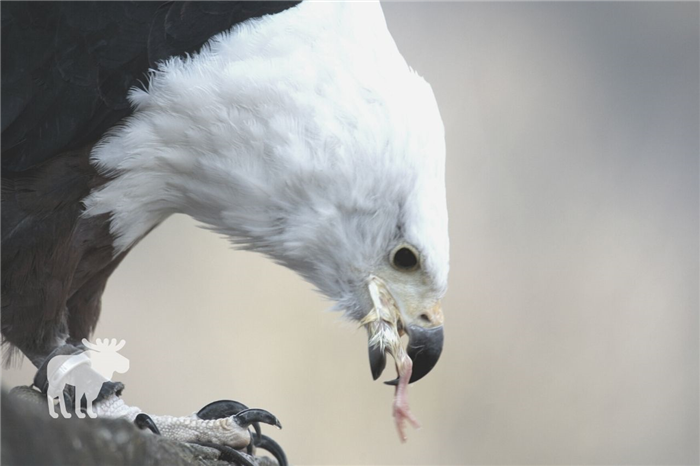
There are many different species of eagle throughout the world, and all of them are carnivorous. That said, what they eat depends largely on the particular species and the region it lives in.
For example, eagles living in desert regions might rely more on reptiles and small rodents, while eagles living near bodies of water may have a diet of mostly fish. In this sense, eagles aren’t terribly picky about their food choices and may be considered opportunistic eaters.
It’s also worth noting that, according to the National Eagle Center, eagles don’t have to eat every day. They generally eat between half a pound and a pound of food per day, but they can eat up to two pounds if they have gone for some time without food.
Let’s take a closer look at some specific food groups and discuss which types of eagles will eat them.
Do Eagles Eat Fish?
Yes, many eagles eat fish. In fact, fish is a top food choice of the bald eagle, which typically lives in wetland environments or near large bodies of water, as well as the African fish eagle.
Eagles have incredible eyesight, which allows them to spot fish in the water as they are flying high above. They are able to track the movements of the fish as they swoop down toward the water, eventually snatching the fish with its powerful talons.
Check out this video to see just how skilled bald eagles are at fishing.
Sometimes the fish is killed as soon as it’s captured, but most often the fish is still alive as the eagle begins to eat it. Eagles prefer fresh meat, and they do not make any special efforts to kill the fish before eating.
Do Eagles Eat Plants?
Because all eagles are carnivores, they don’t typically eat plants. There is no known species of eagle that consumes plants as their primary food source.
That said, many eagles may nibble on plants for various reasons. If there is a patch of grass or weeds growing in the nest, for example, they may pluck it up and eat it.
They may also nibble on pine needles or leaves stuck to branches in their nest–again, as a way of removing them. Sometimes they will even pluck and eat blades of grass from the ground.
Again, though, plants are not really a food source for eagles, and they could not survive on eating plants alone.
Do Eagles Eat Snakes?
For many eagles, especially those who don’t live near bodies of water, snakes are a staple food. The golden eagle and the Philippine eagle are two species that eat snakes as part of their regular diet.
These eagles capture and crush snakes with their talons before eating them. Eagles can only carry animals weighing up to a few pounds, so they are limited to catching small and medium-sized snakes.
Do Eagles Eat Mice?
Yes, there are many species of eagles that eat both mice and rats, such as the golden eagle and the long-crested eagle. Mice and rats make for tasty snacks that are easy to capture, carry, and feed to eaglets.
Again, mice are usually preferred by eagles who don’t live in wetlands or near water sources. Because they are so small, they are also generally preferred by smaller eagles, though this is not always the case.
Do Eagles Eat Rabbits?
Rabbits are a top food choice for a number of different eagle species throughout the world. In North America, both bald eagles and golden eagles have been known to eat rabbits.
Rabbits make a good sized meal for both of these North American eagle species. They are large enough to provide a substantial meal, but light enough for the eagles to capture and carry with ease.
Do Eagles Eat Squirrels?
As you can tell from the above sections in this article, eagles enjoy eating many different species of small mammals. Squirrels are no exception.
Golden eagles in particular eat various types of rodents, reptiles, birds, and even larger mammals such as deer and foxes. They enjoy eating squirrels because they are small and lightweight.
The steppe eagle, found in Europe, Asia, and Africa, is also known for eating squirrels regularly.
Eagles eat squirrels, and other animals, bones and all. They have powerful digestive systems with enzymes that are strong enough to dissolve the bones, which contain many nutrients the eagles need.
Do Bald Eagles Eat Dead Animals?
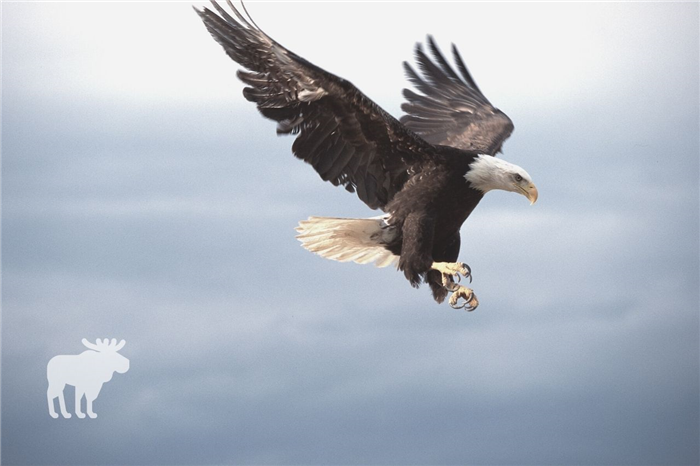
Most eagle species prefer their food fresh and recently killed, but as noted above, they are opportunistic eaters. They will eat dead animals during times of food shortages if they cannot find anything better.
Some eagles, such as the long-crested eagle and the steppe eagle, eat carrion as part of their regular diet. Some are less picky about what they eat and how it was killed, while others are a bit more choosy as long as they are not desperately hungry.
Many eagles will scavenge roadkill, while others will steal the recently-killed prey of other eagles or animals. Still others will eat animals that have died of old age or other causes, which can sometimes harm the eagle.
For example, eagles will sometimes eat dead rats that they find. If a rat was killed by chemical poisoning, then the eagle ingests the poison when it eats the rat and, in turn, may die from the same poison.
In most cases, though, an eagle’s digestive system is able to metabolize almost anything and rid its body of a number of toxins. This is what gives eagles the ability to eat so many different things.
Conclusion
Eagles eat lots of different foods–from tiny mice to deer and foxes–depending on species and location. One thing they all have in common, though, is that all eagles are carnivores and, as such, are considered opportunistic eaters.
1 thought on “What Does An Eagle Eat?”
I have read that eagles will not eat seeds. In fact they are likely to regurgitate seeds if the eat a pigeon that has recently eaten seed. Is this true.
Leave a Comment Cancel reply
This site uses Akismet to reduce spam. Learn how your comment data is processed.
A teacher by profession, Nicky Featherstone has been active in wildlife and nature conservation for nearly thirty years. As a wildlife photographer, he has traveled extensively and studied wildlife sanctuaries across the globe.
Recent Posts
- How To Harvest Oyster Mushrooms?
- How To Identify Wild Oyster Mushrooms?
- How To Get Rid Of Cottonmouth Snakes?
- How Do Cottonmouth Snakes Reproduce?
- What Does A Cottonmouth Snake Eat?
- Elaine on How To Trim A Birch Tree?
- SueFodey on Ash Tree Vs Elm Tree: Side By Side
- Phyllis on What To Do If A Hawk Attacks You?
- Ron Smith on What To Do If You Get Bit By A Copperhead?
- Lois Muhasky on How Does An Armadillo Protect Itself?
ForestWildlife.org
6022 S Drexel Ave
Chicago, IL 60637
Donations
If you would like to support ForestWildlife.org in the form of donation or sponsorship, please contact us HERE.
You will find more information about our wildlife conservation campaigns HERE.
Disclaimer
ForestWildlife.org does not intend to provide veterinary advice. We try to help our visitors better understand forest habitats; however, the content on this blog is not a substitute for veterinary guidance. For more information, please read our PRIVACY POLICY.
Conclusion
As you can see, eagles are opportunistic hunters that utilize their superior sight, speed, flight, and immense initial striking force to hunt all types of prey. Virtually everything that an eagle can kill with a single powerful blow from above is fair game for these predators. From there they will either carry it to their nests if the prey is small enough or they will eat a bit on the spot and take as much as they can home.
This highly specialized hunting strategy helps keep most eagles at the top of their respective food chains. The only time other predators manage to hunt eagles is when they are either too young or too old. In almost all other cases, an adult eagle is the alpha predator of its biome.
